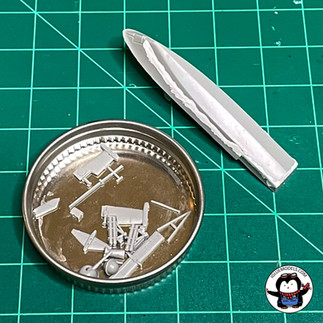A Pegasus-class Hydrofoil
- Mido
- Jul 2, 2022
- 7 min read
Updated: Jul 4, 2022
A model within a model. That sounds cool, and that's exactly what we have with Dragon's 1/700 Oliver Hazard Perry-class USS Ingraham kit, for it contains a bonus Pegasus-class hydrofoil. Awesome!
This is a small boat. But that doesn't mean there isn't a lot to learn. I am going to try pre-shading it with my new Iwata Hi-Line HP-CH airbrush. In terms of precision, this airbrush should be a big improvement over my current workhorse, a Badger Crescendo 175. The Hi-Line sports a Micro Air Control (MAC) Valve and a preset feature to finely tune spray patterns. I reason that if all goes well here, I will replicate the effort for larger ships. Think: Burkes and Ticos. Therefore, consider this an experimental build.
Fitting because "experimental" is an appropriate word to describe the development and production of the 1/1 scale Pegasus-class!

Editor's note: Choose your own content! Click here to be taken to the kit and build, or continue reading to learn about the boat's background.
The boat
I will start with the question on everyone's mind: what is the boat sitting on? Those are hydrofoils mounted on struts. And a hydrofoil is a wing-like surface that generates lift as the speed of the boat increases.
So the boat flies? Sort-of.
In many ways, hydrofoils are analogous to the wings on a plane. Their purpose is to lift a boat's hull out of the water in order to reduce the vessel's hydrodynamic drag. Doing this can increase speed and improve fuel economy. But you can never get something for nothing, and these desirable characteristics are offset by additional complexity and maintenance costs. Therefore, it is relatively rare to see hydrofoil-based craft outside of special purpose vessels where cost sensitivity is not always a primary concern.

Lured by the promise of speed, the US Navy dabbled in hydrofoil research and development through the 50s beginning with the High Pockets and High Tail experimental craft. These two craft tested surface-piercing (High Pockets) versus fully submerged (Hight Tail) foil systems. Surface-piercing foils are self stabilizing while fully submerged foils have improved performance in rough sea states.

Over the years, hydrofoil experimentation continued and even saw a brief detour into the world of amphibious hydrofoils by the US Marine Corps. None were a success. But eventually things got serious and the US Navy commissioned larger craft with fully submerged hydrofoils in the 60s. Two of these, USS Flagstaff (PGH-1) and USS Tucumcari (PGH-2), even deployed to Vietnam.
Then in 1970, Elmo Zumwalt was appointed Chief of Naval Operations. He believed in procuring a cost-effective high-low mix of naval vessels. On the high end would be destroyers and cruisers, while the low end would feature frigates such as the Oliver Hazard Perry-class and gunboats built on hydrofoil technology. Enter the Pegasus-class.

The Pegasus-class were meant to be high-speed, high-performance, low-radar cross section vessels that could operate in the smaller seas and importantly, they would counter emerging Soviet gunboats. It was believed that their presence would free up higher cost surface combatants for blue-water operations.
To achieve its mission, Pegasus-class vessels would be armed with up to 8 Harpoon anti-ship missiles and a Mk 75 76mm OTO Melara gun. Foilborne speeds approaching 48 knots were achieved and powered by a General Electric LM2500 gas turbine engine. A minimal crew of 4 officers and 17 enlisted men were required to operate each vessel. In an effort to keep costs down, the class was envisioned as a NATO standard class. Prospective orders of 30 boats for the United States, 10 for West Germany, and 4 for Italy were budgeted.

Unfortunately, things didn't go smoothly for the Pegasus-class procurement and ultimately the NATO partners backed out and the US Navy only procured 6 vessels. Rather than light up pixels discussing more things budget and bureaucracy, I will write about this: the lead ship of the Pegasus-class, USS Pegasus, was not always USS Pegasus. It was actually USS Delphinus. That's Greek, for dolphin, and also a constellation. But say that three times fast. Sounds a bit like "dull penis" to me. Fortunately, the US Navy agreed. So much so that they changed the name of the lead ship to Pegasus. I can't help but laugh at the poor junior officer that escalated this feedback to their boss.
"Sir, we have a problem. It's the Dull Penis. I mean...the Delphinus, sir."
The entirety of the Pegasus-class found service as a squadron operating out of Key West. Their principal duties involved patrol, anti-smuggling, law enforcement, and doctrine development. All were decommissioned in July 1993 and with them the navy closed the book on hydrofoils. Or did they?

The kit
Pegasus is a niche craft and I’m not aware of a stand-alone kit in 1/700. From what I can tell, it is only boxed with the Oliver Hazard Perry-class kits that, according to scalemates.com, trace their roots to 1990. Like the bigger brother in the box, the Pegasus's detail is well presented and there are a surprisingly large number of parts. And if you had lingering thoughts that the Pegasus was merely a gimmicky toss-in, I am pleased to say that a couple of decals are also provided! Everything points towards a nice little build.
The build
It has become clear to me that building in 1/700 scale is a catch-22: You want the detail that tiny parts give you, but you don’t want the pains of working with tiny parts. Thus I offer a few survival tips:
Use a pair of sharp nippers to remove parts from the sprue.
Clean parts with intention. Some parts might snap just by looking at them! Slow is smooth and smooth is fast.
Use a magnifying lamp combo if you can.
Store loose parts in a vessel to keep them from the carpet monster.
I started by cutting out and sanding all the parts from the sprue. Then I glued the upper hull to the keel. I noticed that there were no guide-marks in the plastic so I did my best to align the two parts and avoid creating a "step". I applied Tamiya's Extra Thin Cement and relied on its capillary action to flow into the seam. Pressure was applied to the two parts until a thin bead of dissolved plastic formed on the outside. The hope is that once dry, the bead can be sanded or scratched off leaving a flush join behind.
Unfortunately, that was not the case. I took remedial action by whittling the step down with a hobby knife, applying Vallejo's Plastic Putty, and dolloping on Tamiya's Liquid Surface Primer. After a round of sanding everything looked as it should.

The rest of the assembly was relatively straightforward. Only a few other minor gaps required attention. And to ease painting, I left off some of the more delicate superstructure pieces.
Painting
I have pre-shaded planes, tanks, and vehicles. Why not ships? Hopefully my new HP-CH will make this a breeze.

Let's get to it, shall we?
Black basing: I started painting with a layer of Tamiya XF-69 NATO Black mixed with some XF-1 Black. I used this darker blend to better approximate the waterline.
Waterline: I added a strip of 1mm Tamiya's Masking Tape to mask-off the waterline.
White highlights: Next I colored the centers of panels with highly thinned coats of Tamiya XF-2 White. I gradually built up the white towards the center of each area. Crucially, I used the HP-CH's Preset Handle to both limit and ensure consistent paint volumes. Using the Preset Handle was a breeze and really helped me achieve the desired effect!
Keel: Some photos of the ship suggest a white-ish keel color. I decided to reuse a cream color from my prior Razorback build.
Horizontal surfaces: I reasoned that it would be easier to paint and mask-off the horizontal surfaces than to start with painting the vertical ones. Tamiya's XF-54 Dark Sea Grey did the trick.
Vertical surfaces: Once the horizontal surfaces were protected, I went in and painted the vertical ones with Tamiya's XF-19 Sky Grey.
The Foils: I painted on Vallejo's Shadows Flesh (70.3437).
Detailing: I used a brush and an assortment of Vallejo's Model Color line to paint various bits and bobs. Vallejo was used because it is a water-based acrylic that will not react with the Tamiya acrylic layers applied previously. If caught early, mistakes can be at least partially wiped away.
Once all the base paint was down, I was able to take a look at the pre-shading effect. It is subtle, but the photos don't do it justice. That being said, I had a feeling that the effort will fade away once I add varnishes and weathering. Ultimately, the model might be too small for the effect to be fully realized.
Finishing up
To decal this kit I used the included "Pegasus" name, and borrowed two number "1"s from possible Oliver Hazard Perry-class builds. They went on without issue.
Next I applied a delicate oil pin wash that I made from black and white Winton Oil Colour paints. At this scale, I wanted something a little more forgiving than the enamel-based Tamiya Panel Line Accent Color that I frequently use. I find the oil pin washes can be feathered more easily, respond to mineral spirits better, and dry slower than their Tamiya counterparts. I also added subtle streaking with the wash, and to compensate for lost pre-shading, I post-shaded with small amounts of pure white.
As a final step, and continuing with the experimental theme of the build, I wanted to break into the world of 1/700 scale ship rigging. Crazy I know. For this, I turned to AK Interactive's Mega-Thin elastic rigging lines. The rigging material itself was easy to work with, however adhering it to the hull with the tiniest amounts of CA glue was a challenge. In the future I will look into a combination of thinner CA glues, a glue looping tool, or UV curable resin glues. I also found cutting the excess rigging line difficult, even while using high precision photoech scissors and tweezers.
Final thoughts
It might seem counterintuitive, but as scale decreases, time spent building can actually increase. The level of precision required on this build, be it working with tiny parts that are routinely captured and rescued from the carpet monster, airbrushing precision, and rigging, all tested me. The point is, small mistakes in the 1/1 working world translate to big ones in the 1/700 display world. It's best not to make any. And that means going slow.
Overall, I am happy with this effort and the unique challenges that this unique vessel presented. On future ship builds I will try the pre-shading technique again (the Preset Handle is amazing) with the hope that a bigger subject will make the shading more apparent and I will also try to refine my approach to rigging.
But until then, my eyes need a break!
Thanks for reading,
Mido
Contact the author: mido@igluemodels.com or on IG and Twitter @igluemodels
Sources, information, and other useful links


















































Comments